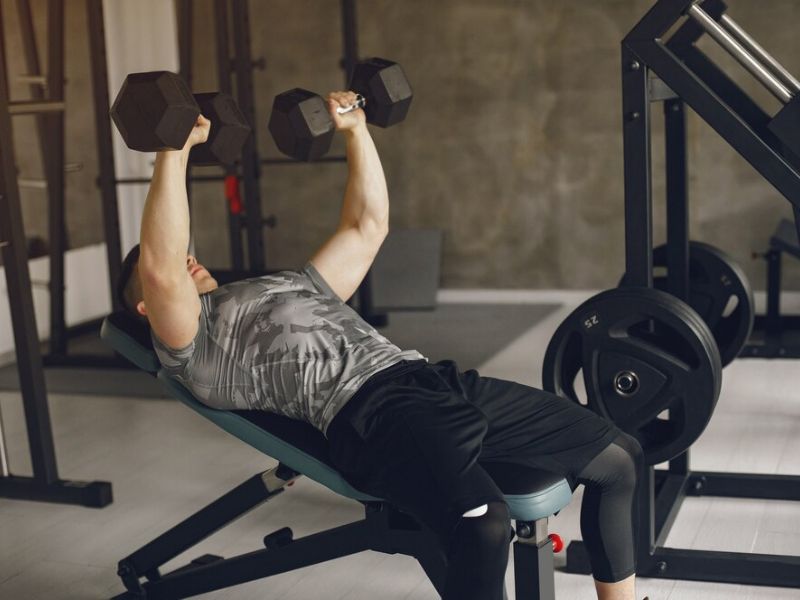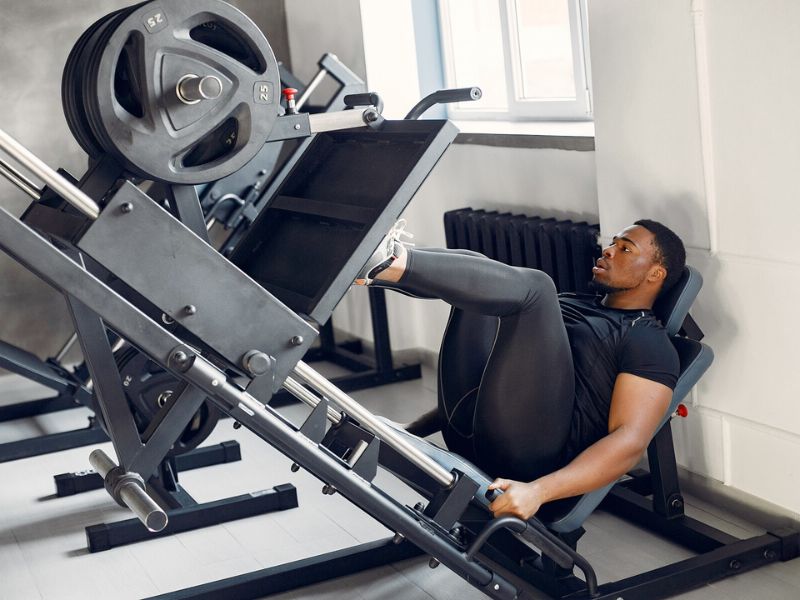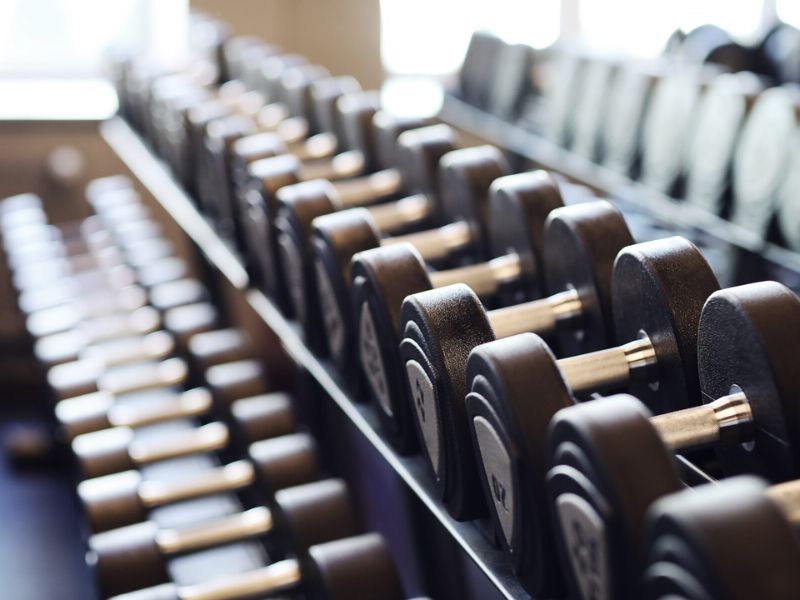Struggling to shed those extra pounds? You’re not alone.
Millions of people look for effective ways to lose weight and improve their overall health.
Did you know that strength training can be a powerful tool in your weight loss journey?
However, for beginners, venturing into the weight room can be intimidating. Proper form and safety are paramount to avoid injuries and maximise results.
This guide will equip you with the knowledge to get started with safe and effective strength training workouts that will fuel your weight loss goals.
A study published in the National Institutes of Health Journal found that strength training, combined with a healthy diet, led to more significant weight loss and fat loss compared to just dieting alone [1].
Building a Safe Foundation for strength training
Exercises to Avoid as a Beginner:

Let’s address some common mistakes beginners make. Here are a few exercises to avoid for now:
- Heavy Barbell Squats: These require a strong core and proper technique to avoid injury. Focus on bodyweight squats or lighter dumbbell squats to build your foundation.
- Weighted Lunges with Improper Form: Lunges can be tricky! Master bodyweight lunges with proper form before adding weights to avoid knee strain.
- Deadlifts: Deadlifts are a fantastic exercise, but they require proper technique to avoid lower back injuries. It’s best to learn them under the guidance of a certified personal trainer.
Why are these risky? These exercises can place a lot of stress on your joints and lower back if not done correctly.
Building proper technique and core strength with bodyweight exercises first will help you avoid injury and progress safely.
Now, let’s talk about the golden rule: proper form.
Proper form is the cornerstone of safe and effective strength training.
Focusing on maintaining correct posture and alignment during each exercise minimizes the risk of injury and ensures that you’re targeting the intended muscle groups.
Utilize resources such as instructional videos or consult with a certified personal trainer to learn and practice proper form techniques.
Getting Started with Strength Training for weight loss
Sample Beginner-Friendly Exercises:
Here are 10 safe and effective gym exercises for beginners that target major muscle groups and promote proper mind-muscle connection:
1. Goblet Squat:

- Targets: Quads, hamstrings, glutes, core
- Mind-Muscle Connection: Focus on engaging your core to keep your back straight and squeeze your glutes as you stand up.
How-to:
- Hold a dumbbell vertically close to your chest, palms facing each other.
- Stand with feet shoulder-width apart and toes slightly pointed outward.
- Engage your core and keep your back straight as you lower yourself down as if sitting in a chair.
- Descend until your thighs are parallel to the ground (or as low as comfortable), keeping your knees tracking over your toes and the dumbbell close to your chest.
- Push back up to the starting position using your heels, squeezing your glutes at the top.
2. Dumbbell Romanian Deadlift:

- Targets: Hamstrings, glutes, core, lower back (stabilizers)
- Mind-Muscle Connection: Feel a stretch in your hamstrings as you hinge at your hips and focus on keeping your core engaged throughout.
How-to:
- Hold a dumbbell in each hand with arms straight down by your sides.
- Stand with feet shoulder-width apart and core engaged.
- Keeping your back straight, hinge at your hips and slowly lower the dumbbells down your legs, pushing your hips back.
- Descend until you feel a stretch in your hamstrings (without rounding your back).
- Maintain a slight arch in your lower back throughout the movement.
- Squeeze your glutes and core to return to the starting position.
3. Incline Dumbbell Bench Press:

- Targets: Chest, shoulders, triceps
- Mind-Muscle Connection: Feel your chest muscles working as you press the dumbbells upwards.
How-to:
- Adjust an incline bench to a 30-degree angle.
- Lie down on the bench with dumbbells held at shoulder level, palms facing forward.
- Engage your core and press the dumbbells straight up until your arms are almost fully extended.
- Lower the dumbbells back down to shoulder level with control.
4. Seated Cable Row:

- Targets: Back muscles (lats), biceps (secondary)
- Mind-Muscle Connection: Focus on squeezing your shoulder blades together at the top of the movement.
How-to:
- Sit on a seated cable row machine and adjust the pad to fit your legs comfortably.
- Grab the handle with an overhand grip (palms facing down).
- Engage your core and keep your back straight as you pull the handle towards your chest.
- Squeeze your shoulder blades together at the end of the movement, then slowly release the handle back to the starting position.
5. Leg Press:

- Targets: Quads, hamstrings, glutes
- Mind-Muscle Connection: Focus on pushing through your heels and squeezing your glutes as you extend your legs.
How-to:
- Adjust the seat and backrest of the leg press machine for a comfortable fit.
- Place your feet shoulder-width apart on the platform and engage your core.
- Slowly lower the platform by bending your knees until your legs form a 90-degree angle.
- Push the platform back up to the starting position using your heels and squeezing your glutes at the top.
6. Dumbbell Shoulder Press:

- Targets: Shoulders (deltoids)
- Mind-Muscle Connection: Feel your shoulders working as you press the dumbbells overhead.
How-to:
- Hold a dumbbell in each hand at shoulder level, palms facing forward.
- Stand with feet shoulder-width apart and core engaged.
- Press the dumbbells straight up overhead until your arms are almost fully extended.
- Lower the dumbbells back down to shoulder level with control.
7. Dumbbell Bicep Curl:

- Targets: Biceps
- Mind-Muscle Connection: Focus on feeling the biceps contract as you curl the dumbbells.
How-to:
- Stand with feet shoulder-width apart and hold a dumbbell in each hand at your sides, palms facing forward.
- Keeping your elbows tucked in by your sides and upper arms still, curl the dumbbells up towards your shoulders.
- Squeeze your biceps at the top of the movement, then slowly lower the dumbbells back down to the starting position.
8. Tricep Pushdowns (Cable or Machine):

- Targets: Triceps
- Mind-Muscle Connection: Focus on feeling the triceps working as you extend your elbows and squeeze at the bottom of the movement.
How-to:
- You can perform tricep pushdowns using a cable machine or a dedicated tricep pushdown machine.
- Adjust the weight or resistance for a challenging 10-12 repetitions.
- Grab the handle with an overhead grip (palms facing down for cable machine) or neutral grip (palms facing each other for dedicated machine).
- Engage your core and keep your upper arms stationary by your sides.
- Push the cable or handle down until your elbows are fully extended, squeezing your triceps at the bottom.
- Slowly return the handle to the starting position with control.
9. Plank:

- Targets: Core (isometric exercise)
- Mind-Muscle Connection: Focus on engaging your entire core to maintain a straight line from head to heels.
How-to:
- Get into a push-up position with your forearms on the ground, elbows shoulder-width apart, and body in a straight line from head to heels.
- Engage your core and glutes to keep your hips from sagging or arching your back.
- Hold this position for as long as you can with good form, aiming for 30-60 seconds for beginners.
Choosing the Right Weight:

Determining the appropriate weight to lift is key to a successful strength training program.
Start with a weight that allows you to perform 10–12 repetitions with proper form.
As you become more comfortable with the exercises, gradually increase the weight to continue challenging your muscles and promoting growth.
Bonus Tip: When it comes to strength training, many people wonder whether it’s better to do high reps with lighter weights or low reps with heavier weights.
Here’s the solution:
If you’re new to resistance training and still getting the hang of exercises, it’s best to start with high reps and lower weights.
This helps you get used to using weights and focuses on building a good connection between your mind and muscles.
For intermediate lifters who have some experience, using higher weights can be beneficial for building more strength.
And importantly, if you’re overweight or not in the best shape, opting for higher reps and lower weights is a smart choice.
This approach can help you sculpt your body more effectively than lifting heavier weights.
So, the key is to tailor your approach based on your experience level and fitness goals, always focusing on proper form and gradual progress.
Building Your Workout Routine
Frequency and Duration:
It’s recommended to engage in strength training sessions 2-3 times per week for optimal weight loss results.
This frequency allows for adequate recovery time between sessions, which is crucial for muscle repair and growth.
Consistency is key, so aim to stick to your workout schedule to see progress over time.
Warm-Up and Cool-Down:

Before starting your strength training session, it’s essential to perform a proper warm-up to prepare your muscles and reduce the risk of injury.
A light cardio warm-up, such as jogging or cycling for 5-10 minutes, increases blood flow to the muscles and raises your body temperature.
Following your workout, incorporate a cool-down period that includes static stretches targeting the major muscle groups worked during your session.
Stretching helps improve flexibility, reduce muscle tension, and promote recovery.
Bonus Tips for Success
Here are some bonus tips to enhance your success, as recommended by Andrew, a NASM-certified personal trainer and the co-founder of Garagegympro:
- Start with Bodyweight Exercises: Begin with bodyweight exercises to build a foundation of strength and proper form. Exercises like squats, lunges, and push-ups are effective for building muscle.
- Listen to Your Body: Pay attention to how your body feels during and after workouts. If you experience pain or discomfort, it’s essential to listen to your body’s signals and take rest days as needed. Pushing through pain can lead to injury and setbacks in your fitness journey.
- Maintain a Healthy Diet: Alongside strength training, focus on nourishing your body with a balanced diet rich in lean protein, fruits, vegetables, and whole grains.
- Start with a Fitness Assessment: Understand your current fitness level. This could be as simple as noting how long you can walk before feeling winded or how many squats you can do without stopping.
- Learn Proper Form: Before starting any exercise, make sure you understand how to perform it correctly to avoid injuries. Consider working with a trainer or watching instructional videos from reputable sources.
- Progress Gradually: Increase the intensity and duration of your workouts gradually to avoid overtraining and injuries.
- Stay Hydrated: Drink water before, during, and after workouts to stay hydrated. Aim for about 16 to 20 ounces (0.5 to 0.6 liters) of water 1 to 2 hours before exercise. During your workout, consume approximately 8 ounces (0.24 liters) of water every 15 to 20 minutes. After exercising, replenish fluids by drinking about 16 to 24 ounces (0.5 to 0.7 liters) of water for every pound (0.45 kilograms) of body weight lost during the workout. Remember, hydration is important for supporting optimal performance and recovery.
Conclusion
Congratulations on taking the first step towards a healthier you.
This guide has equipped you with the foundational knowledge to embark on a safe and effective strength training journey for weight loss.
Remember, consistency is key.
By incorporating these principles and gradually progressing, you’ll be well on your way to building strength, burning fat, and achieving your weight loss goals.

